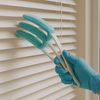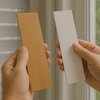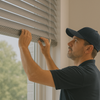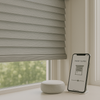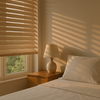How Professional Blind Cleaning Extends the Life of Your Window Coverings
- by Mariam Labadze
Quick Answer
Professional blind cleaning extends lifespan by 3-5 years through specialized techniques removing embedded dirt, grease, and allergens that regular dusting cannot address. Deep cleaning prevents material degradation—accumulated grime breaks down fabrics, corrodes mechanisms, and creates permanent staining that eventually necessitates replacement. Professional services use ultrasonic cleaning for venetians, steam treatment for fabrics, and appropriate solutions for each material type avoiding damage that improper home cleaning causes. Annual or biannual professional cleaning costs £15-£40 per blind but prevents premature replacement expenses of £50-£150+ per window. Combined with regular home maintenance (weekly dusting, spot cleaning), professional deep cleaning maintains appearances, ensures smooth operation, and maximizes return on window treatment investments.
Why Regular Cleaning Matters
Dirt Accumulation Causes Damage – Dust and grime aren't merely cosmetic issues—they actively degrade blind materials over time. Particles embedded in fabric fibers act like sandpaper during operation, abrading surfaces and weakening structural integrity. On mechanisms, dust combines with lubricants creating abrasive pastes that wear moving parts accelerating mechanical failures.
Kitchen blinds face particular challenges. Cooking grease particles settle on surfaces, attracting more dirt whilst the oils gradually stain and stiffen fabrics or mechanisms. This combination proves difficult removing once established, often requiring professional intervention preventing permanent damage.
Allergen and Health Concerns – Blinds accumulate dust mites, pollen, pet dander, and mold spores creating reservoirs of allergens affecting indoor air quality. Regular cleaning reduces these accumulations benefiting respiratory health, particularly for asthma sufferers, allergy-prone individuals, and young children spending substantial time indoors.
Professional deep cleaning eliminates allergens that surface dusting merely redistributes, creating genuinely cleaner environments rather than simply moving particles from blinds to other surfaces where they continue affecting air quality.
Operational Deterioration – Dirt in mechanisms causes binding, uneven movement, and increased operational force requirements. This resistance accelerates wear on cords, chains, and internal components whilst making daily use frustrating. Professional cleaning restoring smooth operation prevents this deterioration extending mechanical lifespan significantly.
What Home Cleaning Cannot Achieve
Surface vs. Deep Cleaning – Weekly dusting or vacuuming removes loose surface particles but cannot extract embedded dirt within fabric weaves, accumulated grease on slat surfaces, or grime deep in venetian blind mechanisms. This surface maintenance proves essential but insufficient alone for long-term blind health.
Home spot-cleaning addresses visible marks but often uses incorrect products or excessive moisture causing water stains, fabric shrinkage, or warping that professional techniques avoid through appropriate solutions and controlled application methods.
Material-Specific Requirements – Different blind materials demand specialized cleaning approaches that most homeowners lack equipment and expertise providing. Fabric Romans require gentle extraction methods, wooden venetians need careful moisture control, and delicate cellular structures demand specific handling preventing cell collapse or internal moisture trapping.
Professional services maintain extensive knowledge of material-specific requirements, applying appropriate techniques to each blind type rather than universal approaches that risk damaging sensitive materials whilst inadequately cleaning robust ones.
Professional Cleaning Methods
Ultrasonic Cleaning for Venetians – This revolutionary technique immerses blinds in ultrasonic baths where high-frequency sound waves create microscopic bubbles that implode against surfaces, dislodging dirt from every crevice without mechanical scrubbing that might damage finishes.
Ultrasonic cleaning reaches areas impossible accessing manually—inside slat channels, around tilt mechanisms, between tightly spaced slats. This comprehensive cleaning restores blinds to near-original condition, removing years of accumulated contamination that home methods cannot address.
The process proves particularly effective for aluminum and faux wood venetians, though real wood requires moisture-sensitive approaches that ultrasonic immersion doesn't accommodate without risk.
Steam Cleaning for Fabrics – Professional-grade steam cleaners provide deep cleaning and sanitization for fabric blinds, Romans, and cellular shades. The high-temperature steam kills dust mites, bacteria, and mold whilst loosening embedded dirt that extraction immediately removes before it resettles.
Controlled steam application avoids over-wetting that causes shrinkage, color bleeding, or fabric distortion. Professional equipment and expertise ensure appropriate moisture levels for specific fabrics—enough cleaning effectively whilst avoiding damage that excessive water creates.
Solvent-Based Treatments – Some stubborn contaminants—particularly oil-based kitchen grease—resist water-based cleaning requiring specialized solvents that break down these substances without damaging blind materials or finishes.
Professional services use appropriate solvents for specific situations, understanding which chemicals safely apply to various materials whilst effectively removing targeted contaminants. This expertise prevents the material damage that incorrect solvent use causes, including finish removal, discoloration, or structural weakening.
On-Site vs. Off-Site Cleaning – Some services clean blinds in place through careful application of appropriate solutions and extraction techniques. This convenience avoids removal and reinstallation but proves less thorough than off-site cleaning where blinds undergo comprehensive immersion or controlled environment cleaning impossible replicating on-site.
Off-site professional cleaning allows complete material inspection, mechanism servicing, and comprehensive treatment impossible during quick in-home visits. For maximum benefit, choose services offering removal, shop cleaning, and professional reinstallation.
Frequency Recommendations
Annual Professional Cleaning – Most households benefit from annual professional deep cleaning supplementing regular home maintenance. This frequency prevents excessive dirt accumulation whilst spreading costs across manageable annual expenses rather than accumulating until problems necessitate emergency intervention.
High-exposure areas—kitchens, bathrooms, south-facing windows—might warrant twice-annual professional cleaning addressing accelerated soiling from cooking, humidity, or intense sunlight that creates more challenging cleaning requirements than typical interior conditions.
Signs Professional Cleaning Is Overdue – Visible discoloration despite regular home cleaning, mechanisms operating roughly or requiring excessive force, persistent odors from fabrics, or obvious grease/grime accumulation all signal that professional intervention will prevent further deterioration requiring more expensive repairs or premature replacement.
Don't wait until blinds appear obviously dirty—proactive professional cleaning prevents reaching that point, maintaining appearances and function continuously rather than allowing gradual decline until problems become undeniable.
Cost vs. Replacement Economics
Professional cleaning typically costs £15-£40 per blind depending on size, material, and cleaning complexity. For an average home with 12 blinds, annual professional cleaning totals £180-£480—substantial expense that requires justification through value delivered.
Consider replacement costs providing perspective. Quality blinds cost £50-£150 per window, making complete replacement £600-£1,800 for 12 windows. If professional cleaning extends lifespan from 7 to 10 years, that three additional years of service from £180 annual cleaning proves economically sound—£540 cleaning investment over those three years versus £600-£1,800 replacement costs.
This calculation becomes even more favorable for premium blinds costing £150-£300 per window where replacement represents £1,800-£3,600 investment. Regular professional maintenance protecting these substantial investments through extended lifespans delivers clear economic benefits beyond the immediate satisfaction of clean, attractive window treatments.
DIY Maintenance Between Professional Cleanings
Weekly Dusting – Use microfiber cloths, vacuum brush attachments, or specialized blind dusters removing loose surface particles before they embed in materials or accumulate in mechanisms. This five-minute weekly routine prevents the buildup that necessitates more intensive cleaning whilst keeping blinds looking presentable continuously.
Close venetian blinds fully when dusting, wiping entire surfaces systematically. For fabric blinds, gentle vacuuming on low suction prevents fabric damage whilst effectively removing dust accumulation.
Spot Cleaning – Address spills and marks immediately before they set permanently. Use slightly damp microfiber cloths and mild soap for most materials, testing inconspicuous areas first ensuring cleaning methods don't cause discoloration or damage.
Avoid excessive moisture, particularly on wooden blinds or fabric treatments. Damp rather than wet cloths prove sufficient for most spot cleaning, preventing water damage whilst effectively removing fresh marks.
Mechanism Maintenance – Periodically check operating mechanisms, lubricating moving parts with appropriate products maintaining smooth operation. This simple maintenance prevents the resistance buildup that accelerates wear whilst making daily use frustrating.
Examine cords, chains, and brackets for wear or loosening, addressing minor issues before they develop into operational failures requiring professional repairs or premature replacement.
Material-Specific Care Guidelines
PVC and Aluminum – These durable materials tolerate more aggressive home cleaning including damp wiping with mild detergent solutions. For thorough home cleaning, remove blinds and rinse under showers or with hoses, ensuring complete drying before reinstalling preventing moisture in mechanisms.
Avoid abrasive cleaners or scrubbing pads that might scratch surfaces. Soft cloths and gentle cleaning solutions maintain appearances without damage even during vigorous cleaning.
Real Wood – Exercise extreme caution with moisture around wooden blinds. Use barely damp cloths for wiping, never spray cleaners directly onto wood, and dry immediately preventing moisture absorption that causes warping or finish damage.
Periodic application of wood conditioning products maintains finishes whilst preventing drying or cracking. Follow manufacturer recommendations regarding appropriate products for your specific finish type.
Fabric Treatments – Vacuum regularly using upholstery attachments preventing dust embedding in fabric weaves. For spot cleaning, use fabric-appropriate cleaners, testing first on hidden areas. Avoid over-wetting that causes shrinkage, color bleeding, or water staining visible even after drying.
Consider professional cleaning annually for fabric blinds in high-use or high-soil areas where home maintenance alone cannot maintain acceptable cleanliness and appearance.
Cellular Shades – The delicate honeycomb structure demands gentle handling. Vacuum carefully using low suction and soft brush attachments, never pulling or compressing cells during cleaning. For deep cleaning, professional services understand appropriate techniques preventing cell collapse or internal moisture trapping that home cleaning might cause.
Choosing Professional Services
Verify Experience and Methods – Ask specific questions about cleaning techniques for your blind types. Reputable services explain their processes, demonstrate material-specific knowledge, and provide references from satisfied customers with similar window treatments.
Beware services using identical methods regardless of material—appropriate professional cleaning demands tailored approaches recognizing different requirements across blind types and materials.
Insurance and Guarantees – Ensure services carry appropriate insurance covering potential damage during cleaning or transportation. Request guarantees of satisfaction or policies addressing damage caused by cleaning processes, protecting your investment if services fail meeting reasonable expectations.
Pricing Transparency – Obtain detailed quotes specifying per-blind costs, any additional charges for materials requiring special handling, and what services include (removal, cleaning, reinstallation). This transparency prevents surprise charges whilst enabling accurate cost comparisons between service providers.
At 1 Click Blinds, whilst we specialize in supplying quality window treatments, we recommend establishing relationships with professional cleaning services extending your investment's lifespan. Regular professional maintenance combined with appropriate home care ensures your blinds remain beautiful, functional, and healthy components of your home for maximum possible duration, delivering superior return on your window treatment investment.

